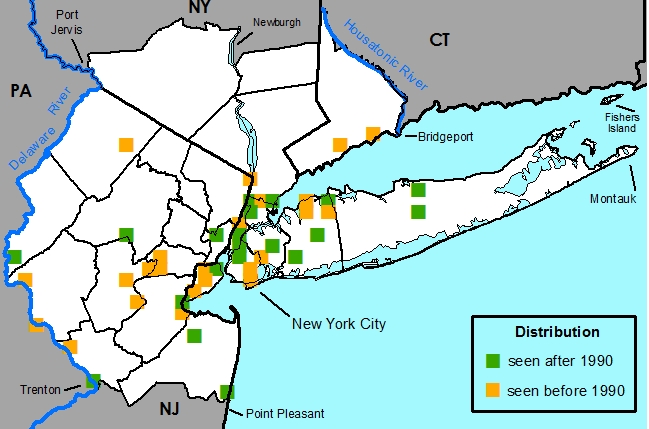Broussonetia papyrifera (L.) Vent. - Paper Mulberry
Non-native , Occasional
By Katherine Gould, Angela Steward
Not peer reviewed
Last Modified 07/01/2013

Common Names
Paper MulberryField Identification
Small tree 1-40 ft, often formimg thickets; Bark- green to gray, furrows with age; Leaves- alternate, sometimes opposite, simple, 3-8 inches long, oval to heart-shaped, upper surface rough, velvet beneath; Flowers- dioecious, both pale green, male flowers elongated, 1-2.5 inches long, females flowers round 0.5 inches in diameter; Fruit- an aggregate of red drupes.Medicinal uses
Disclaimer: The information provided here is for reference and historical use. We do not recommend nor do we condone the use of this species for medicinal purposes without first consulting a physician.The leaves, fruit, and bark of this species all have medicinal value. The leaf juice, for example, can serve as a laxative but is also useful in the treatment of dysentery. Furthermore, the juice can help ease the discomfort of skin irritations, such as insect bites. The twig bark can be cooked with other foods to help digest lactose products. Finally, the fruit is a diuretic and can be ingested to cure stomach pains due to indigestion.
Other uses
The tree has long been used in many paper, clothing, and wood products in Eastern Asia. Branches are used in paper production when leaves have fallen off the tree. After they are harvested, the branches are steamed so that fibers can be stripped from the inner bark. In more humid areas, it is not necessary to steam the braces to remove the fiber. Later, the fiber is treated with lye and pounded into different paper varieties. The coarse-grained wood, though not very durable, is easily worked to produce bowls, cups and other dishes.Nomenclature
Broussonetia papyrifera (L.) L'Hér. ex Vent., Tabl. Regne Veg. 3:547 (1799).Morus papyrifera L., Sp. Pl. 986 (1753).
Streblus cordatus Loureiro, Fl. Cochinch. 615 (1790).
Papyrius japonicus Lamarck ex Poiret, Encycl. Mkth. Bot. 5:3 (1804).
Broussonetia papyrifera normalis Seringe, Descr. Cult. Mfiriers, 236; Atl. 14, t. 26 (1855).
Broussonetia papyrifera var. japonica Blume, Mus. Bot. Lugd.- Bat. 2:86 (1856).
Broussonetia Kazi hort. Sieb. ex Blume, 1. c. (1856), pro syn.
Description
PLANTS Perennial, deciduous, phanerophytic, trees or shrubs, diclinous and dioecious, 7-15 m tall, small trees or shrubs with milky sap.STEMS Main stems erect. Bark smooth or furrowed, not exfoliating, tan or brown. Branches ascending. Twigs brown, not odoriferous, rounded, zigzag, hispid to villous when young, lenticellate, glabrescent or not glabrescent. Pith white, round, continuous, nodal diaphram absent. Sap white. Resin absent.
BUDS Axillary only, scattered along stem, 1 per axil, conical, 2 mm long, pointed, sessile. Bud scales 2-3, brown, coriaceous, glabrous or sparsely pubescent marginally, with an outer striate scale. Bud scale scars not encircling the stem. Leaf scars rather large, rounded, elevated, 3-4 mm wide. Vascular bundle scars 5, compound, aggregated in an ellipse.
LEAVES Alternate or subopposite, distichous, spaced somewhat evenly along stem, divergent from stem, simple. Stipules present, lateral, deciduous, free from the petiole, scale-like, margins entire, ovate-lanceolate with attenuate tips, greenish, villous, 8-14 mm long, 4-9 mm wide, early deciduous, stipule scars long and narrow. Leaves petiolate, petiole terete, 2-10 cm long, densely pubescent, not glabrescent, without glands. Leaf blades ovate to widely ovate, asymmetric or bilaterally symmetric, 5-18 cm long, 2.5-14 cm wide, membranaceous, palmate or weakly 3-veined from base, base cuneate, obtuse or cordate, margin entire, serrate or doubly serrate, unlobed or irregularly 2-5(-7)-lobed, apex acuminate or acute. Abaxial surface densely white-villous throughout, not glabrescent, without glands. Adaxial surface muricate to scabrous or slightly villous on veins, not glabrescent, without glands.
FEMALE INFLORESCENCES Axillary, globose heads 1.0-1.8 cm in diameter in flower, up to 3.2 cm broad in fruit, subsessile or peduncle up to 5 mm.
FEMALE FLOWERS 4-merous. Calyx stereomorphic, tubular or salverform, of fused sepals, persistent, with 4 small pubescent lobes and a very short, glabrous, orange tube in flower, the persistent tube elongates in fruit up to 8 mm long, bearing the fruit in its mouth. Corolla absent. Gynoecium pseudosyncarpous. Carpels 1. Locules 1. Stigmatic surface papillose along the length of the style. Style 1, persistent, 4-7 mm long, threadlike, puberulent, pink. Ovary superior, 2 mm long, stipitate, glabrous. Stamens absent. Staminodes absent.
MALE INFLORESCENCE Axillary, flexuous catkins, 18-65 mm long, 4-7 mm wide, greenish with pale stamens. Peduncle 1-6 mm long. Rachis stout, villous, subtended by minute, villous bracts. Pedicels very short.
MALE FLOWERS 4-merous. Calyx present, actinomorphic, campanulate, of fused sepals, greenish yellow, 1 mm long. Sepal lobes 4, elliptic to rounded, villous. Corolla absent. Androecium exserted, introrse. Stamens 4, 1.5-2.1 mm long, creamy. Anthers globose, white. Filaments free, straight, fleshy. Staminodes absent. Gynoecium absent.
FRUITS Drupetum/syncarps. Individual drupelets red or orange, with a reticulate, stony endocarp, borne on a gynophore 3-4 mm long and exserted from the tip of the persistent perianth, spheroidal, glabrous. Syncarps globose, 2-3 cm diameter, slimy.
SEEDS Seeds 1, dark reddish-brown, ovoid-lenticular, flattened on one edge and slightly keeled on the other, ca 3 mm long, ca 2 mm wide, glabrous, testa rugose.
Habitat
Common in moist areas near streams, in open and forested upland areas, and urban-cultivated situations.Distribution
United States -- AL, AR, CT, DL, FL, FL, GA, HW, IL, ID, KS, LA, MD, MA, MI, MO, NJ, NY, NC, OH, OK, PA, RI, SC, TN, TX, VA, WV.Canada –
New York Metropolitan Region – Introduced and naturalized within the NY Metropolitan area.
Rarity Status
Heritage global rank – not listedConnecticut -- not listed
New Jersey -- not listed
New York -- not listed
Species Biology
FloweringMay [ week 4] – June [week 2]
Pollination
Fruiting
Dipersal
Germination